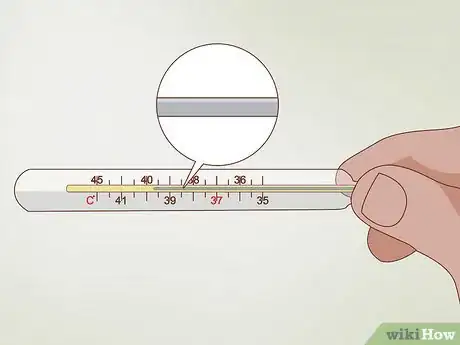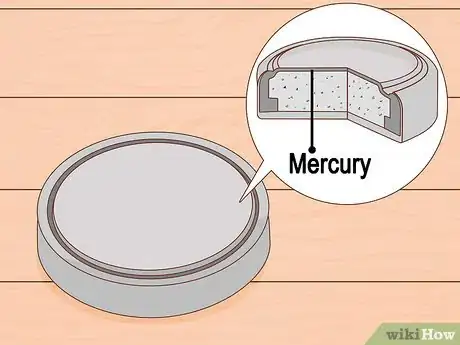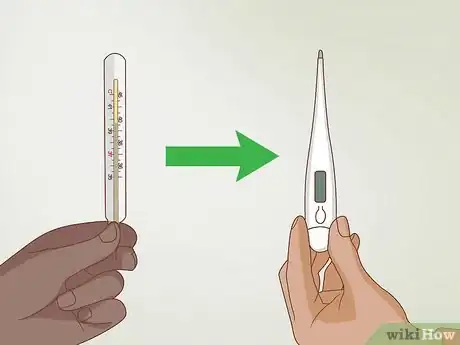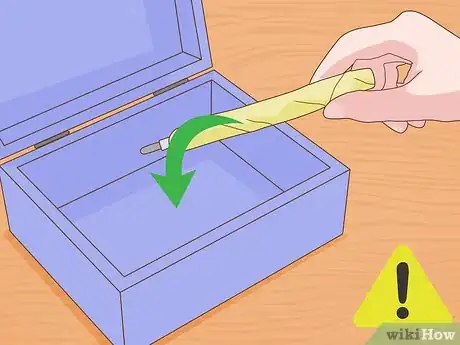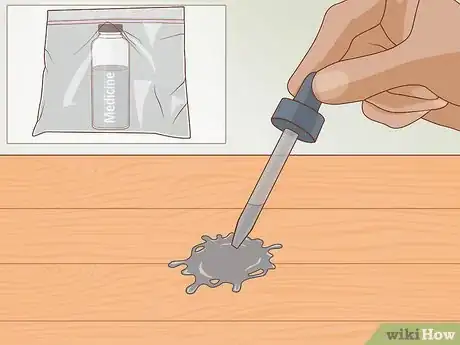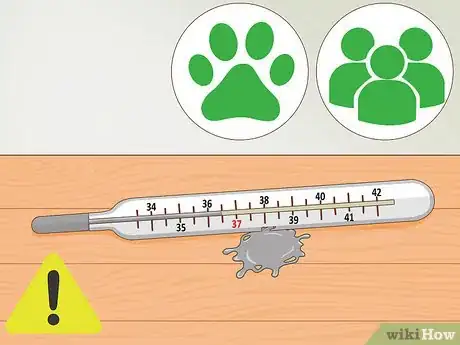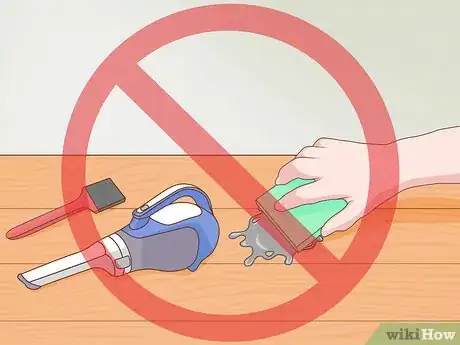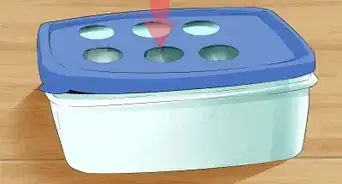This article was co-authored by Bess Ruff, MA. Bess Ruff is a Geography PhD student at Florida State University. She received her MA in Environmental Science and Management from the University of California, Santa Barbara in 2016. She has conducted survey work for marine spatial planning projects in the Caribbean and provided research support as a graduate fellow for the Sustainable Fisheries Group.
There are 13 references cited in this article, which can be found at the bottom of the page.
This article has been viewed 107,587 times.
Mercury (sometimes called quicksilver) is naturally found in rocks and soils, and is liquid at room temperature. Mercury is a toxic substance that can cause neurological disorders and damage to the nervous system.[1] To locate mercury in the home, start by checking your gauges and meters. Thermometers, barometers, and other meters often contain liquid mercury. You could also check certain light bulbs, antiques, and small batteries for mercury. If you successfully locate liquid mercury in your home, use caution so as not to spill or vaporize it.
Steps
Inspecting Gauges and Devices
-
1Check your thermometer. Some old thermometers used mercury to measure the temperature. If you see a shiny liquid sloshing about your old thermometer, it could be liquid mercury.
-
2Check your barometer. If you have an old barometer—a device used to measure air pressure—it could contain liquid mercury. Look for a silvery-white liquid inside the central tube of the barometer.[2]
- You might be keeping a barometer on the interior or exterior of your home.
Advertisement -
3Look for mercury in gas-fired appliances. A common element in many gas-fired appliances is a mercury heat (or flame) sensor. Also called automatic gas shut-off valves, these small gadgets are used in ovens, furnaces, and water heaters to stop the flow of gas if the flame does not produce heat. Inspect these devices in your home for the presence of liquid mercury.[3]
-
4Check other gauges and meters. There are a wide variety of other specialty gauges and devices in which you might be able to locate liquid mercury. For instance, if you have a medical condition, you might own a sphygmomanometer (a blood pressure meter) that uses liquid mercury to measure blood pressure. Other gauges containing liquid mercury include:
- esophageal dilators, bougie tubes, or gastrointestinal tubes
- flow meters
- hydrometers
- psychrometers
- manometers
- pyrometers
Locating Mercury in Home Products
-
1Identify compact fluorescent light bulbs. Older incandescent light bulbs do not contain liquid mercury. But, some newer energy-saving compact fluorescent light (CFL) bulbs do. Check the packaging that the bulbs came in for warnings regarding their mercury content.[4]
- Energy-saving bulbs typically contain no more than 4 mg of mercury—just enough to cover the tip of a pen.
- Even if the CFL bulb contains mercury, it might be in gaseous rather than liquid form.
- LED bulbs don’t contain liquid mercury.[5]
-
2Locate mercury in tilt switches. Tilt switches (sometimes called “mercury switches”) were used in older appliances to transmit an on/off signal. Appliances in the home that may contain mercury include chest freezers, televisions, thermostats, washing machines, space heaters, clothes dryers, and washing machines.[6]
- Contact the appliance manufacturer or check your user manual to confirm if a given appliance has mercury.
- Contact an appliance recycler or your local hazardous waste collection center for information regarding the best way to dispose of these appliances.
- You might be able to locate up to 3 grams of mercury in thermostats.
-
3Find mercury in small batteries. Most normal batteries do not contain mercury. However, the smaller “button cell” batteries that are used in watches, hearing aids, toys, pacemakers, and other devices still contain mercury. If you can find a device containing these small batteries, you’ve probably found liquid mercury.[7]
-
4Search for mercury in pharmaceuticals. Certain pharmaceutical products might contain liquid mercury. Skin antiseptics, facial creams, contact lens solutions, and some vaccines could contain liquid mercury. To confirm that your pharmaceutical products contain liquid mercury, check the ingredients label or contact the manufacturer.[8]
-
5Check antique clocks. Clocks from the 1600s or before often used liquid mercury as a pendulum weight. If you own such a clock, it probably contains liquid mercury.[9]
Avoiding Contact with Liquid Mercury
-
1Replace devices that contain mercury. Once you’ve identified objects that contain or might contain liquid mercury in your home, replace them with items that do not contain mercury. For instance, trade in your old mercury thermometer for a digital thermometer.[10]
-
2Handle mercury-containing devices with caution. If you have, for instance, an old glass thermometer that contains liquid mercury, do not carelessly toss it on your counter. Instead, place it gently on a padded surface and store it safely.[11]
- For instance, you might wrap a thermometer that contains liquid mercury in a soft blanket and place it in a sturdy wooden box.
-
3Recycle items that contain mercury. Do not throw bulbs or other mercury-containing items in the trash. They might break, contaminating you or the sanitation workers who recover them. Instead, contact your local recycling center and ask if they accept items containing mercury.[12]
- If they do, follow their directions for disposal.
- If they do not, ask if they know of another facility that can accept household items containing liquid mercury.
Dealing with Spills
-
1Clean up small spills with a medicine dropper. If you spill a small amount of mercury (the amount that you might find in an average mercury thermometer), alert others in the house that they should avoid the area until you’ve cleaned it up. Don a pair of disposable gloves and use a medicine dropper to suck up the liquid mercury. Place the droplets in a sealed container (for instance, an old medicine bottle).[13]
- Place the medicine dropper you used and the container with the liquid mercury in a sealed plastic bag.
- Contact your waste disposal service to find out how to dispose of the liquid mercury.
-
2Contact experts for large spills. If you’ve spilled an amount of mercury in excess of what would be found in an average thermometer, leave your home immediately. Contact your local health department for information about air testing and cleanup.[14]
-
3Keep pets and people away from mercury spills. If liquid mercury escapes its appliance, gauge, or other device, keep others away from the spill. This will reduce their contact with the mercury and prevent it from spreading throughout the house.
-
4Do not attempt to clean up liquid mercury using conventional means. Vacuuming can vaporize liquid mercury. This will likely lead to you or someone else in the house inhaling the mercury, increasing your exposure. Additionally, don’t try to use a sponge or brush when cleaning up liquid mercury.[15]
- Vacuuming or using a sponge on liquid mercury will only contaminate your sponge or vacuum.[16]
-
5Cut away pieces of carpet that came in contact with mercury. If you’ve located liquid mercury in your home’s carpet, cut away the area containing the mercury (including the carpet pad beneath). Fold the carpet and pad carefully to avoid spilling the liquid mercury beads, then place it in a garbage bag.[17]
Community Q&A
-
QuestionDoes mercury melt in room temperature?
 Community AnswerMercury melts at -38.83 and boils at 356.7 degree Celsius. So in between this temperature mercury exists in liquid state. Beyond the boiling point, it exists as gas and below the freezing point, it exist as solid state. Since room temperature is in between it's boiling point and freezing point, mercury exists as liquid state at room temperature.
Community AnswerMercury melts at -38.83 and boils at 356.7 degree Celsius. So in between this temperature mercury exists in liquid state. Beyond the boiling point, it exists as gas and below the freezing point, it exist as solid state. Since room temperature is in between it's boiling point and freezing point, mercury exists as liquid state at room temperature. -
QuestionWhat is the use of mercury?
 Community AnswerIt's used in chemistry experiments. It was also used in old thermometers, because it expanded at a higher rate than other available materials and only boiled/froze at extreme temperatures.
Community AnswerIt's used in chemistry experiments. It was also used in old thermometers, because it expanded at a higher rate than other available materials and only boiled/froze at extreme temperatures. -
QuestionWhat will show that there is mercury in the area?
 Community AnswerThe needle held on a rope becomes attracted to the poles and becomes straight if there is mercury.
Community AnswerThe needle held on a rope becomes attracted to the poles and becomes straight if there is mercury.
Warnings
- Do not ingest or directly handle mercury. Minimize exposure of skin to mercury by wearing rubber gloves.⧼thumbs_response⧽
- Keep all products containing mercury away from especially children, pregnant women, and the elderly, as they can be more susceptible to the harmful effects.⧼thumbs_response⧽
References
- ↑ http://www.dw.com/en/just-how-dangerous-is-mercury-anyway/a-16522491
- ↑ https://www.mnn.com/earth-matters/translating-uncle-sam/stories/which-household-items-contain-mercury
- ↑ https://www.epa.gov/mercury/mercury-consumer-products#list%3C/reF
- ↑ http://www.nhs.uk/chq/Pages/854.aspx?CategoryID=87
- ↑ https://www.michigan.gov/documents/mdch/CFL_Fact_Sheet_193840_7.pdf
- ↑ https://www.epa.gov/mercury/mercury-consumer-products#list
- ↑ https://www.mnn.com/earth-matters/translating-uncle-sam/stories/which-household-items-contain-mercury
- ↑ http://epa.ohio.gov/portals/41/p2/mercury_pbt/mercur.pdf
- ↑ http://www.newmoa.org/prevention/mercury/projects/legacy/antiques.cfm
- ↑ http://www.floridadisaster.org/hazmat/serc/documents/Mercury%20Brochure.pdf
- ↑ http://www.floridadisaster.org/hazmat/serc/documents/Mercury%20Brochure.pdf
- ↑ http://www.floridadisaster.org/hazmat/serc/documents/Mercury%20Brochure.pdf
- ↑ http://www.floridadisaster.org/hazmat/serc/documents/Mercury%20Brochure.pdf
- ↑ http://www.floridadisaster.org/hazmat/serc/documents/Mercury%20Brochure.pdf
- ↑ http://www.nhs.uk/chq/Pages/854.aspx?CategoryID=87
- ↑ http://www.floridadisaster.org/hazmat/serc/documents/Mercury%20Brochure.pdf
- ↑ https://www.michigan.gov/documents/mdch/MercurySpillQA_216567_7.pdf
- ↑ https://www.mnn.com/earth-matters/translating-uncle-sam/stories/which-household-items-contain-mercury
- ↑ http://epa.ohio.gov/portals/41/p2/mercury_pbt/mercur.pdf
- ↑ http://epa.ohio.gov/portals/41/p2/mercury_pbt/mercur.pdf
